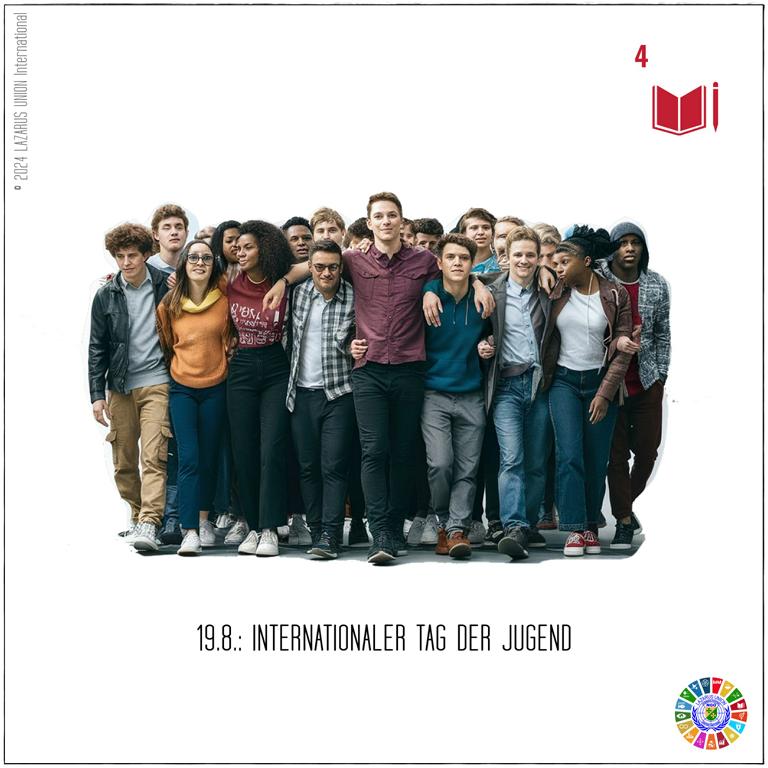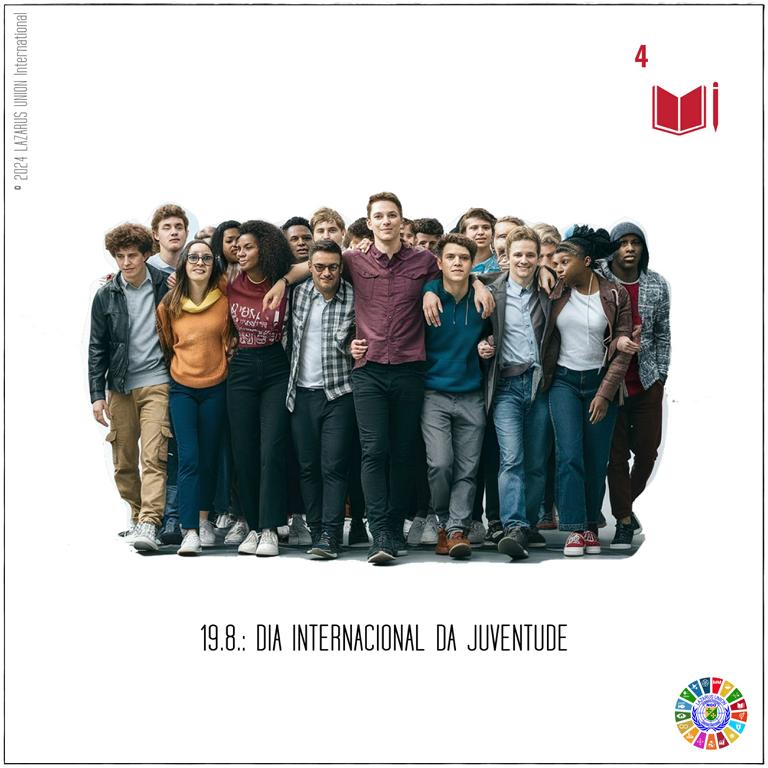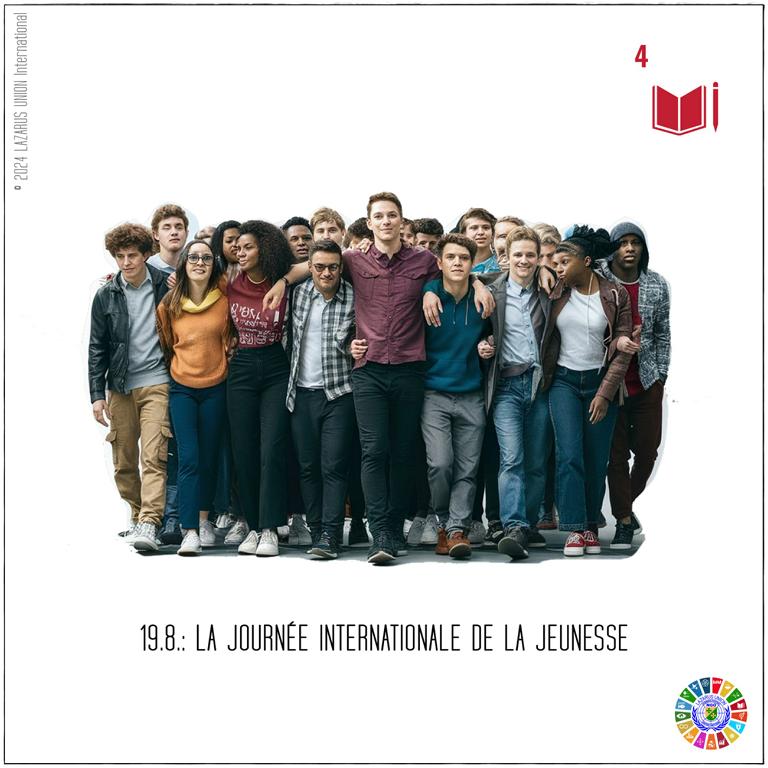This year’s International Zero Waste Day focuses on fashion and textiles. The earth is a victim of fashion. Thousands of chemicals are often used in the production of textiles, many... Read more
International Youth Day
Introduction
International Youth Day, observed annually on August 12th, is a celebration of young people’s voices, actions, and initiatives, recognizing their pivotal role in shaping a sustainable and inclusive future. This day also highlights the challenges faced by the world’s youth, emphasizing the need for concerted efforts to address issues such as education, employment, health, and civic engagement. In the context of the 2030 Agenda for Sustainable Development and the United Nations Sustainable Development Goals (SDGs), International Youth Day underscores the critical importance of empowering young people to achieve these global objectives. For the Lazarus Union, an international NGO with general consultative status with the United Nations Economic and Social Council (ECOSOC), this day reinforces its commitment to youth advocacy, support, and development.
Context of the 2030 Agenda and the SDGs
The 2030 Agenda for Sustainable Development, adopted by all United Nations Member States in 2015, provides a shared blueprint for peace and prosperity for people and the planet. At its heart are the 17 SDGs, which are an urgent call for action by all countries in a global partnership. Youth are at the center of this agenda, as they represent not only beneficiaries but also key drivers of sustainable development.
Several SDGs are particularly relevant to youth:
- SDG 4 (Quality Education): Ensuring inclusive and equitable quality education and promoting lifelong learning opportunities for all.
- SDG 8 (Decent Work and Economic Growth): Promoting sustained, inclusive, and sustainable economic growth, full and productive employment, and decent work for all.
- SDG 10 (Reduced Inequalities): Reducing inequality within and among countries.
- SDG 13 (Climate Action): Taking urgent action to combat climate change and its impacts.
Data and Statistics on Global Youth
The global youth population, defined as individuals aged 15-24, represents approximately 1.2 billion people, or 16% of the world’s population (United Nations, 2020). This demographic is growing, particularly in developing countries, where young people constitute a significant portion of the population.
Education
- According to UNESCO, about 258 million children and youth were out of school in 2018, including 59 million at the primary level, 62 million at the lower secondary level, and 138 million at the upper secondary level.
- Despite progress, disparities in education persist, with marginalized groups, particularly girls and young women, being disproportionately affected.
Employment
- The global youth unemployment rate was estimated at 13.6% in 2020, nearly three times higher than the adult unemployment rate (ILO, 2020).
- Young people are more likely to be employed in informal, temporary, or low-wage jobs with poor working conditions and limited social protection.
Health
- Mental health issues are a significant concern, with suicide being the second leading cause of death among 15-29-year-olds (WHO, 2019).
- Many young people lack access to adequate healthcare services, including sexual and reproductive health education and services.
Civic Engagement
- Youth participation in political processes remains low, with only 2.2% of parliamentarians worldwide being under the age of 30 (IPU, 2018).
- However, young people are increasingly active in social movements and advocacy, particularly around climate change and social justice.
Best Practices and Case Studies
Case Study 1: Youth for Climate Action
Youth-led climate movements, such as Fridays for Future, have gained international prominence. Initiated by Greta Thunberg, this movement has mobilized millions of young people worldwide to demand urgent action on climate change.
Best Practices:
- Grassroots Mobilization: Empowering youth to lead and organize local climate strikes and campaigns.
- Global Networks: Building international networks to share knowledge, strategies, and support.
- Policy Advocacy: Engaging with policymakers to advocate for stronger climate policies and commitments.
Case Study 2: The Youth Empowerment Project (YEP) in Gambia
YEP aims to improve the employment prospects of young Gambians through skills development, entrepreneurship training, and access to finance. The project focuses on high-potential sectors such as ICT, tourism, and agriculture.
Best Practices:
- Skills Training: Providing market-relevant skills training and vocational education.
- Entrepreneurship Support: Offering mentorship, business development services, and access to microfinance.
- Public-Private Partnerships: Collaborating with government agencies, private sector, and international organizations to create sustainable opportunities.
Case Study 3: Youth Civic Engagement in Tunisia
Post-Arab Spring, Tunisian youth have been actively involved in rebuilding their country’s political landscape. Organizations like Al Bawsala have empowered young people to participate in democratic processes and hold their government accountable.
Best Practices:
- Civic Education: Educating young people about their rights and responsibilities as citizens.
- Advocacy Training: Equipping youth with the skills to advocate for policy changes.
- Digital Platforms: Using technology to facilitate civic engagement and monitor government activities.






Relevance for the Lazarus Union
The Lazarus Union’s commitment to youth empowerment is integral to its mission as an international NGO with general consultative status with ECOSOC. The organization can leverage this status to amplify youth voices and advocate for policies that support young people globally.
Key Actions for the Lazarus Union:
- Youth Advocacy: Promoting the interests and rights of young people in international forums and policy discussions.
- Education and Training: Offering programs that provide youth with skills, knowledge, and opportunities for personal and professional development.
- Partnerships: Collaborating with youth organizations, governments, and other NGOs to implement projects that benefit young people.
- Monitoring and Reporting: Using data and research to monitor the impact of youth-focused initiatives and report on progress towards the SDGs.
Conclusion
International Youth Day is a powerful reminder of the significant role young people play in achieving the 2030 Agenda for Sustainable Development. By recognizing their contributions and addressing the challenges they face, we can harness the potential of youth to drive positive change. For the Lazarus Union, this day emphasizes its ongoing commitment to youth empowerment, advocacy, and development, reinforcing the importance of investing in young people as key agents of sustainable development.
Through continued efforts and partnerships, we can create an inclusive and supportive environment where all young people can thrive and contribute to a better world.
References
- United Nations. (2015). Transforming Our World: The 2030 Agenda for Sustainable Development.
- United Nations. (2020). World Youth Report: Youth Social Entrepreneurship and the 2030 Agenda.
- UNESCO Institute for Statistics. (2019). Out-of-School Children and Youth.
- International Labour Organization. (2020). Global Employment Trends for Youth 2020.
- World Health Organization. (2019). Adolescent Mental Health.
- Inter-Parliamentary Union. (2018). Youth Participation in National Parliaments.








